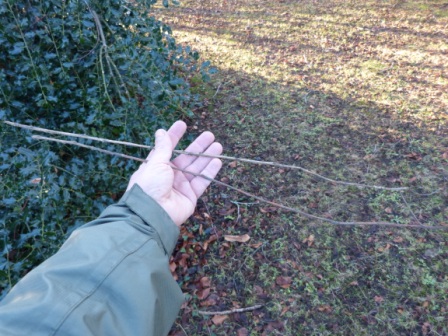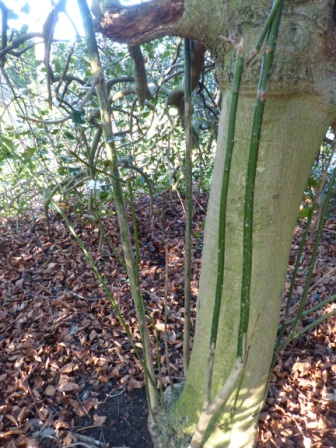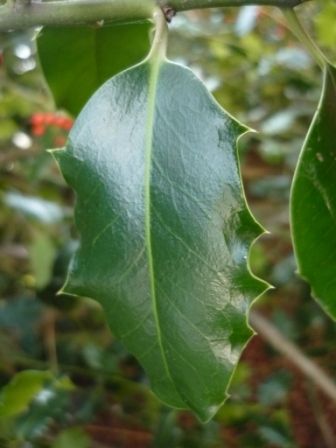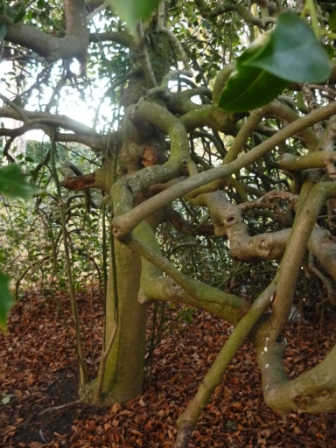9 BUSHCRAFT USES OF HOLLY:
. The holly is a great bushcraft tree. Below is a list of 10 bushcraft uses of the holly tree. 1. KINDLING 2. FUEL 3. CARVING WOOD 4. FEATHER STICKS 5. FLAMMABLE BARK 6. BOW-DRILL LUBRICANT 7. LONG, STRAIGHT BRANCHES 8. NATURAL SHELTER 9. LEAF LAYER OF DEBRIS SHELTER1. KINDLING: The branches of living holly tree possess an unusually high number of attached, dead, thin, long and flammable twigs. They are often of ideal length, dryness and thinness for the small twig fire, and just as importantly - it’s possible to collect many dead, holly twigs in a short period of time – important, if you need to get a fire going quickly.

Holly trees have an abundance of thin, long, dry dead twigs attached to living branches - they are exceptionally good kindling (Photo: Sean Fagan).
.
2. FUEL: The dead wood of holly burns hot and long as a fuel. A lot of dead wood from holly trees has, for some reason, many small holes running throughout the timber which greatly increases its combustibility (more oxygen). The holes could be the remnant burrows of wood-boring insect larvae. Many holly trees have large dead limbs still attached to the living tree. These sizable limbs are often vertical, or near vertical, and easy to dislodge. The more vertically aligned deadwood is, the drier it usually is (sheds rain better). Large, dead holly branches can be easily broken into shorter lengths by bashing the dead branches over something hard e.g. a large rock/boulder. No sawing or axe sectioning is generally required. However, be careful when forcefully breaking large branches.
3. CARVING WOOD: Dense, smooth and often of clean, ivory-white colour – the wood is exceptionally attractive. Although the wood can be hard to carve, it holds a hard wearing edge and is an ideal choice for robust carving projects, although be warned – the wood can be prone to splitting at the ends when dried too quickly. It’s important that holly wood has been dried (seasoned) gradually, especially if you are planning on using the wood for important carving projects, such as a knife handle.
4. FEATHER STICKS: Admittedly, holly is not a first choice wood for feather sticks. It’s hard to acquire sufficient lengths of holly wood that is knot-free. Also, dead holly tends not to yield long, multiple-curled shavings when carved. However, it’s possible to make small feather sticks from holly – it’s just that more of them are required to make a large enough mass of curls for a sure-thing fire in damp conditions – anything between 4-8 feather sticks. How many feather sticks is exactly needed depends on your feather-stick making skills and the quality of the holly wood that you are using (make sure to make plenty of thin splints as well!). So, why bother making inferiour feather sticks from Holly? There are deciduous woodlands that have a vigorous under storey of holly with few other tree species present. In those instances, holly can be the best feather stick choice and since bushcraft is very much about expanding our skill sets for all eventualities... : )
5. FLAMMABLE BARK: Birch is not the only deciduous tree in town that has flammable bark. Mature holly trees, especially standing, dead holly trees, sometimes shed a peeling bark that is flammable - certainly not as flammable as birch bark, nor does holly bark come off in the same copious quantities as birch bark – but comes off it does, and its flammable - and can give you a fire-lighting edge when you need it.
6. BOW DRILL LUBRICANT: The leaves of holly, when crushed, are fantastically waxy. Holly leaves make a first-class lubricant for the handhold (bearing block) of the bow drill. Personally, I admire the way my drill spins in the handhold when lubricated with holly leaves. Makes drilling a lot easier which enables me to spin my drill as fast as possible with less effort. Seriously, I’ve found holly leaves to be a great bow drill lubricant and so will you. Occasionally, I will put a few holly leaves in my pocket when the opportunity presents itself – just in case I decide to make a bow-drill fire in a location where holly trees are absent.
7. STRAIGHT, STRONG BRANCHES: Not a whole lot of deciduous tree species naturally produce straight branches. Of course, some tree species when coppiced, such as hazel and sweet chestnut, produce an abundance of straight branches. Un-coppiced holly is generous in its gift of straight branches. Strong, long and tough – the straight branches that grow as secondary growth on the larger branches or a basal growth at the bottom of the main tree trunk have multiple, potential uses - shelter construction, throwing sticks, batons, digging sticks, arrows, spring traps and pot suspension are just a few applications for the straight, tough and long branches of holly. It’s not hard to see why, historically, holly branches were once used for making spears and chariot axles.

Straight and strong branches growing from the base of a holly tree. Holly branches are also quite elastic (high-tensile strength). (Photo: Sean Fagan).
8. SHELTER: An unusual application of holly. The dense, evergreen canopy of holly can provide a discreet, well-sheltered site. Many holly trees have a canopy that reaches close to, or to, the ground. Such trees are great for wildlife observation, or as a sheltered spot for sitting out inclement weather (while getting a quick brew on) or as a discreet camping site. Bonus: the thick evergreen canopy of holly tends to disperse campfire smoke very well – important if you want to maintain a low-impact presence in an area.
9. LEAF LAYER OF DEBRIS SHELTER: The thick, leathery leaves of holly provide great insulation for natural shelters such as the leaf-debris hut and the leaf-debris group shelter. Rain tends to be shed off more efficiently from a shelter cocooned in holly leaves. Gathering the spiny, holly leaves can be challenging - usually some form of hand protection is required. However, where there are holly leaves there are obviously – holly trees, so making a nice, natural shelter under a benevolent holly canopy can provide additional weather-buffing.



Recent Comments